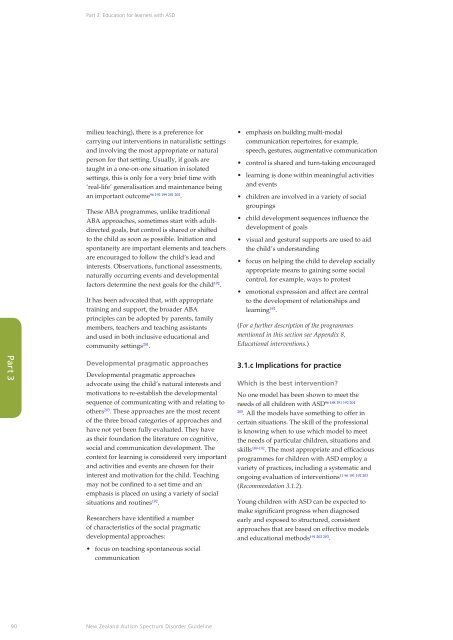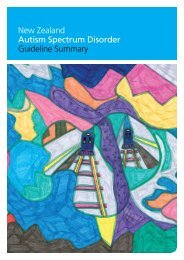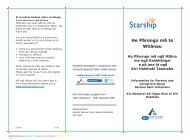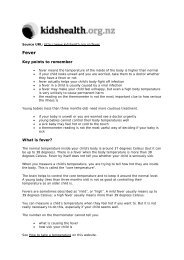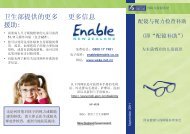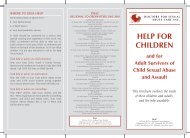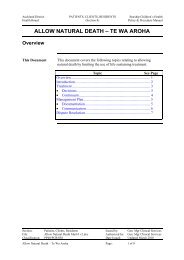New Zealand Autism Spectrum Disorder Guideline - Ministry of Health
New Zealand Autism Spectrum Disorder Guideline - Ministry of Health
New Zealand Autism Spectrum Disorder Guideline - Ministry of Health
You also want an ePaper? Increase the reach of your titles
YUMPU automatically turns print PDFs into web optimized ePapers that Google loves.
Part 3: Education for learners with ASD<br />
milieu teaching), there is a preference for<br />
carrying out interventions in naturalistic settings<br />
and involving the most appropriate or natural<br />
person for that setting. Usually, if goals are<br />
taught in a one-on-one situation in isolated<br />
settings, this is only for a very brief time with<br />
‘real-life’ generalisation and maintenance being<br />
an important outcome 96 192 199 201 202 .<br />
These ABA programmes, unlike traditional<br />
ABA approaches, sometimes start with adultdirected<br />
goals, but control is shared or shifted<br />
to the child as soon as possible. Initiation and<br />
spontaneity are important elements and teachers<br />
are encouraged to follow the child’s lead and<br />
interests. Observations, functional assessments,<br />
naturally occurring events and developmental<br />
factors determine the next goals for the child 192 .<br />
It has been advocated that, with appropriate<br />
training and support, the broader ABA<br />
principles can be adopted by parents, family<br />
members, teachers and teaching assistants<br />
and used in both inclusive educational and<br />
community settings 201 .<br />
• emphasis on building multi-modal<br />
communication repertoires, for example,<br />
speech, gestures, augmentative communication<br />
• control is shared and turn-taking encouraged<br />
• learning is done within meaningful activities<br />
and events<br />
• children are involved in a variety <strong>of</strong> social<br />
groupings<br />
• child development sequences influence the<br />
development <strong>of</strong> goals<br />
• visual and gestural supports are used to aid<br />
the child’s understanding<br />
• focus on helping the child to develop socially<br />
appropriate means to gaining some social<br />
control, for example, ways to protest<br />
• emotional expression and affect are central<br />
to the development <strong>of</strong> relationships and<br />
learning 192 .<br />
(For a further description <strong>of</strong> the programmes<br />
mentioned in this section see Appendix 8,<br />
Educational interventions.)<br />
Part 3<br />
Developmental pragmatic approaches<br />
Developmental pragmatic approaches<br />
advocate using the child’s natural interests and<br />
motivations to re-establish the developmental<br />
sequence <strong>of</strong> communicating with and relating to<br />
others 203 . These approaches are the most recent<br />
<strong>of</strong> the three broad categories <strong>of</strong> approaches and<br />
have not yet been fully evaluated. They have<br />
as their foundation the literature on cognitive,<br />
social and communication development. The<br />
context for learning is considered very important<br />
and activities and events are chosen for their<br />
interest and motivation for the child. Teaching<br />
may not be confined to a set time and an<br />
emphasis is placed on using a variety <strong>of</strong> social<br />
situations and routines 192 .<br />
Researchers have identified a number<br />
<strong>of</strong> characteristics <strong>of</strong> the social pragmatic<br />
developmental approaches:<br />
• focus on teaching spontaneous social<br />
communication<br />
3.1.c Implications for practice<br />
Which is the best intervention?<br />
No one model has been shown to meet the<br />
96 188 191 192 204<br />
needs <strong>of</strong> all children with ASD<br />
205<br />
. All the models have something to <strong>of</strong>fer in<br />
certain situations. The skill <strong>of</strong> the pr<strong>of</strong>essional<br />
is knowing when to use which model to meet<br />
the needs <strong>of</strong> particular children, situations and<br />
skills 189-192 . The most appropriate and efficacious<br />
programmes for children with ASD employ a<br />
variety <strong>of</strong> practices, including a systematic and<br />
11 96 191 192 203<br />
ongoing evaluation <strong>of</strong> interventions<br />
(Recommendation 3.1.2).<br />
Young children with ASD can be expected to<br />
make significant progress when diagnosed<br />
early and exposed to structured, consistent<br />
approaches that are based on effective models<br />
and educational methods 191 202 203 .<br />
90<br />
<strong>New</strong> <strong>Zealand</strong> <strong>Autism</strong> <strong>Spectrum</strong> <strong>Disorder</strong> <strong>Guideline</strong>


